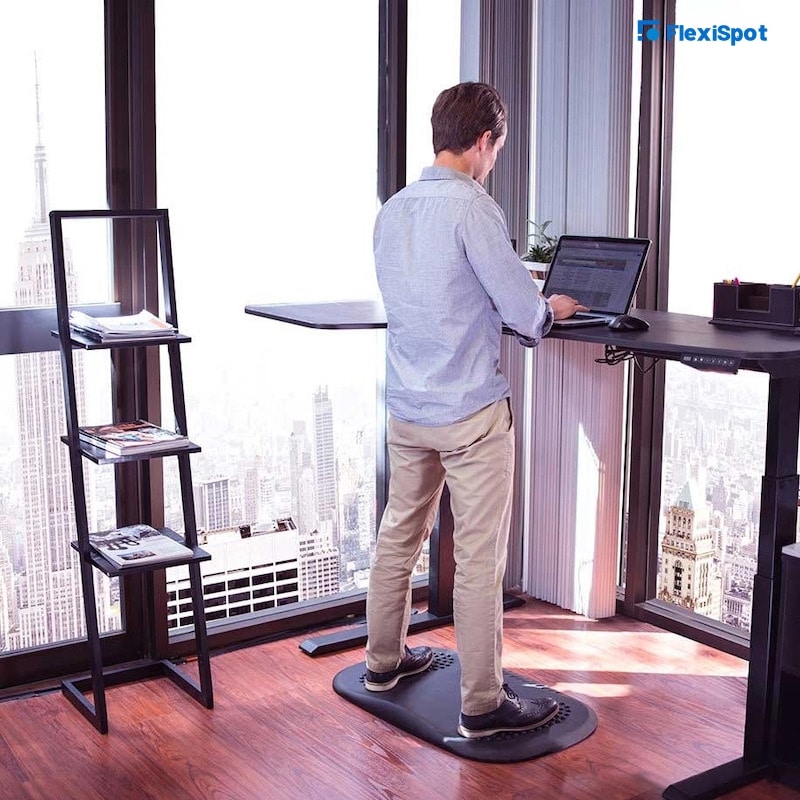Occupational safety regulations are standards set to guarantee that you are safe at your workplace. Why are these standards so important? Well, numerous studies have shown that the average employee loses 1 to 4 working days due to work-related health complications. Of these health concerns, musculoskeletal injuries top the chart for office workers. Studies show that over 50% of office workers have experienced a form of musculoskeletal injury in their lifetime- even the fittest people have trouble staying healthy when they're stuck at a desk all day.
Billions of dollars are spent on workers’ compensation, health insurance premiums by employers, and loss on sales annually due to work-related health complications. And, outside of the physical and mental anguish caused to the patient (employee), they also experience a reduction in quality of life, introducing the need for ergonomic assessments in the workplace.
An ergonomic assessment is thorough scrutiny of the workspace, furniture, equipment, and accessories to determine their effectiveness towards employee productivity and comfort level in their work environment. Your office chairs could be costing you a fortune in chiropractic copays; your tables could be the cause of rampant RSI diagnosis amongst your workers or standing on hardpan surfaces while working at standing desks could be undoing the intended benefits of the investment.
Ergonomic assessments help you address the root cause of the problems and provide grounds for their mitigation budgetary allocation. The best part is that this does not require an external auditor. The office manager or safety officer (or teams assigned with the task) can follow the guidelines we’ll summarize in this article. We’ll also provide solutions that could help mitigate the problem at hand.
Let’s run through the process of Ergonomic Assessment:
Review Existing Data
Ergonomic assessments are usually conducted by fully qualified occupational health professionals or, in some cases, by in-house safety employees equipped with expertise, skills, and understanding in ergonomics and human safety.
The consultant will evaluate your work history to identify the existing data to understand your baseline. This includes determining:
Human resource records on the number of sick days taken by the employees because of work-related injuries, which could be: strains, sprains and tears, carpal tunnel syndrome, back pains, and hernias.
Costs incurred on workers’ compensation due to work-related injuries in your company.
Health insurance claims are filed and paid out to employees due to work-related injuries and musculoskeletal disorders.
First aid logs and reports by employees treating work-related injuries related to musculoskeletal disorders.
This data will help identify the common injuries and the high-risk work activities in each workstation.
The consultant will also review your previous ergonomic assessment report. This assessment will guide the expert to determine if the information aligns with the risk factors present in your workplace. The expert will be checking on:
What were the risk factors identified in the report as being present in the workplace?
The proper use of ergonomic assessment tools for the risk factors identified.
Check on implementation of the findings on the previous report.
Establishing a Standard Ergonomic Assessment Tool
Choosing the wrong ergonomic risk assessment tool is like taking a knife to a gunfight. It can be a waste of time and frustrating if it doesn't work or yields fewer results after implementation. An ergonomic assessment tool should be effective, efficient, and scientifically valid. Most importantly, the job under evaluation needs to be matched with the right tool.
Below are some assessment tools for use in an office setup.
RULA - Rapid Upper Limb Assessment
This tool assesses the postural load requirement of a job on the trunk, neck, and upper body. It’s a diagnostic tool used to evaluate the force, repetitions, and body posture. Scores are entered for each body region after the evaluation. Data is collected to compile the risk factor variables, generating a score representing the levels of musculoskeletal risk.
REBA - Rapid Entire Body Assessment
This diagnostic tool systematically investigates the ergonomic design and whole-body postural musculoskeletal disorders related to job tasks. It evaluates the types of movements and actions, forceful repetitions, body posture, and coupling.
Scores are taken on knees, legs, wrists, forearms, shoulders, neck, and back. Data is collected to compile the risk factor variables, generating a score representing the levels of musculoskeletal risk.
Quick Screening
A hazard recognition tool is used to identify and document the recent cases of observed and known musculoskeletal hazards for further evaluation.
Job Screening
It is a quick and straightforward method of screening jobs to identify levels of moderate or high-risk tasks associated with musculoskeletal disorders.
Subjective Data Collection from the Employees
An ergonomic consultant will typically take thirty minutes to one hour while conducting an ergonomic assessment in a workstation. This involves questioning the employees on the tasks they perform on a daily basis and the perceived wear and tear they undergo at the end of the day from these tasks.
The questioning manner should be compassionate and open-minded to yield more results from the employees. Below is an OSHA-approved checklist for ergonomic assessment.
1. Do you perform tasks that require the assumption of awkward positions like; squatting, hunching, or bending? Do these positions require excessive use of a particular joint for an extended period?
2. Do the tasks you perform require lifting weights?
3. Do you perform highly repetitive tasks?
4. Do you experience body soreness on the knees, legs, back, shoulders, neck?
5. Have you been diagnosed with any of the following carpal tunnel, trigger finger, white finger, tendonitis, hand-arm segmental vibration syndrome, or DeQuervain’s disease?
6. Do you use the best tool suitable for a task? Does that promote neutral postures?
7. Do you perform tasks that require you to use excessive force application?
8. Do you receive ergonomic training on the tasks?
9. Are there procedures in place to accommodate fluctuations in staff levels?
10. Do you have channels in place to communicate ergonomic concerns?
Collection of Objective Data
Objective data refers to information gathered by the assessor engaging the five senses. It can take the form of observation or measurement of the following areas:
1. Are there unnecessary steps taken when conducting tasks?
2. Do the employees show signs of fatigue and reduced productivity?
3. Are the workstations for the employees too high or low?
4. Are the employees provided with good nutrition?
5. Are there potential obstacles on the floors?
6. Is the office temperature conducive for the employees?
7. Are the workstations properly fitted with adequate lightning?
8. Is there adequate space in between workstations? Does it offer distance, especially during this pandemic era?
9. Are the breaks provided to the employees adequate during work hours?
10. Are materials handled under the knees and above the shoulders?
11. Are the workstations adequately lit to perform the tasks?
12. Is there noise in the workplace?
13. Do the employees perform specific tasks in a standing position for long periods?
Assessing the Data and Prioritizing the Risk
Once you have your data, it is time to take a step back and analyze what you have learned so far. Begin by answering the questions below:
What are the levels of risk in the workplace?
Significance of injury risk in the workplace.
How can you reduce the risks?
Some of the results you might get from an analysis of the existing data responses from the employee engagement and observation records could be:
Awkward work postures resulting in pains and aches.
Temperature extremes create an unconducive environment for the employees.
Poor lighting or excessive lighting in the work station.
Excessive noise.
Forceful exertions.
Contact stress.
Poor nutrition.
If so, rank the results in terms of highest to lowest risk. Mitigate the highest risk factors immediately, then hop onto the lower priority factors.
Priority Levels in Risk Assessment
There are certain factors considered when allocating priority levels. These factors differ from industry to industry, based on the nature of work, organization's size, cost of implementing solutions, the urgency to resolve issues, and immediate practicality (e.g., space, need to assign time off to implement, etc.).
Outlined are 5 qualities to consider when assigning priority levels on a 5-point scale.
Highest priority level
The presence of injury, work discomfort, and other risks in a workstation
High priority level
The presence of injury but no work discomfort and other ergonomic risks in the workstation.
Moderate priority level
The absence of injury but the presence of work discomfort.
Low priority level
The absence of injury and work discomfort but the presence of other ergonomic risks in the workstation.
Lowest priority level
The absence of injury and work discomfort, and other ergonomic risks in the workstation.
A Plan to Implement Mitigation Measures
As a rule of thumb, always go for the lowest cost and simplest solutions to get the ball rolling. This makes your implementation plan immediate and proves its actionability. It also gives the organization tangible results while giving them time to gather resources to implement the resource-intensive measures.
Based on your findings, below are possible measures that you can implement.
Engineering Controls
These will include:
Provide the employees with desks that are height adjustable to reduce strain.
Place telephone headsets within reach of employees that use them
Provide stationery and tools to each workstation to reduce unnecessary twisting and stretching.
Provide your employees with ergonomic chairs and stools
Supply the office with anti-fatigue floor mats.
Adjust the work surface height to prevent awkward postures.
Change the workplace layout to improve space. Improve storage solutions to increase the space for movement.
Administrative Controls
The management can make allocations for the following:
Limit overtime and reduce shifts for your employees.
Practice job rotation.
Encourage your staff to take frequent but constructive short breaks.
Provide training on recognition of risk factors.
Provide a breakroom for your staff with healthy snacks.
Personal Protective Equipment
Allow your employees to wear headgear to reduce noise interruptions.
Wrist splints can be provided for workers who perform tasks that require wrist bending.
The Areas that you can Improve After the Ergonomic Assessment
Some of the ergonomic adjustments that you can make in the wake of an assessment include:
Improve Desktop Surfaces
Desks come a dime a dozen. You might be tempted to say that the perfect desk does not exist. But, in the current ergo-aware work environment, furniture shops have really stepped it up. Consider height adjustable standing desks. These desks accommodate employees within a wide height range and ensure that the surface height is in the most ergonomic position. These desks also allow intermittent sitting and standing for improved blood circulation, posture, and ultimately, productivity.
The height adjustment allows for pairing with office-workout equipment such as under-desk treadmills and under desk bikes for even better health management. The Adjustable Desk Series from Flexispot, is one such solution, with a dual lifting motor, high loading capacity, energy-efficient LED display, anti-collision, and comes in either bamboo, laminated or solid wood tabletop.
Ergonomic Office Accessories
Provide your employees with accessories that can make their work environment more friendly.
Monitor mounts- They are adjustable depending on the screen-height needs of your employees. The majority give you accessories that make your workstation a delight to work from.
Monitor arms- They extend your monitor off the desktop to a preferred height.
Anti-fatigue mats- These are useful to cushion the feet of employees that stand for long hours.
Standing Desks Converters- They can be a convenient way to switch positions if your budget doesn't allow for complete standing desks.
Turning the Break Room into a Haven for Relaxation
Design a break room that actually allows the workers to break from work. Whether they only take 15-minute coffee breaks or hour-long lunch breaks, it will significantly benefit them to have a space that relieves them of the tension in the workspace and allows them to re-energize. Ensure that the break room:
Provides an ambiance that is different from the office. You could even consider an outdoor setting, where the environment is different.
Has a sitting plan that is conducive to relaxation.
Has sufficient airflow and light.
Well accessorized- should have a refrigerator and microwave.
Fully stocked. Keep a supply of tea, coffee, sugar, and milk for your staff.
The room should be clean and well maintained.
Let it be an information room. Pay for newspaper and magazine subscriptions and install a television.
The room should be brightly colored to represent a cheery mood.
Upgrade your office with Ergonomic chairs
Ergonomic chairs are meant to provide your employees with support and comfort during their long work hours. They also prevent musculoskeletal disorders related to poor posture. The Ergonomic Office Mesh Chair is the perfect budget-friendly seat, offering armrests and a breathable, well-ventilated backrest. It is also height-adjustable to adjust to the diverse height range of your employees.
Optimize storage space
Workstations and office spaces should be clutter-free, providing easy access to files and the office floor. A good filing cabinet with a smart design that occupies minimal space can be the solution you need to keep your office clutter-free. Get a solution that has easy-roll casters for convenient movement and a high vertical alignment to make the most economical use of space.
Conclusion
An ergonomic assessment is a necessity in any modern workspace. A proactive approach to your employee’s problems is much more efficient in creating a healthy workspace as compared to reactive measures after the harm is done. Get ahead of the problem and take control of potential hazards like musculoskeletal disorders that result from poor ergonomics. Additionally, consider checking into other health hazards associated with conditions such as dust, rodents, water contaminants, etc., to ensure a 100% safe environment for you and your employees.







